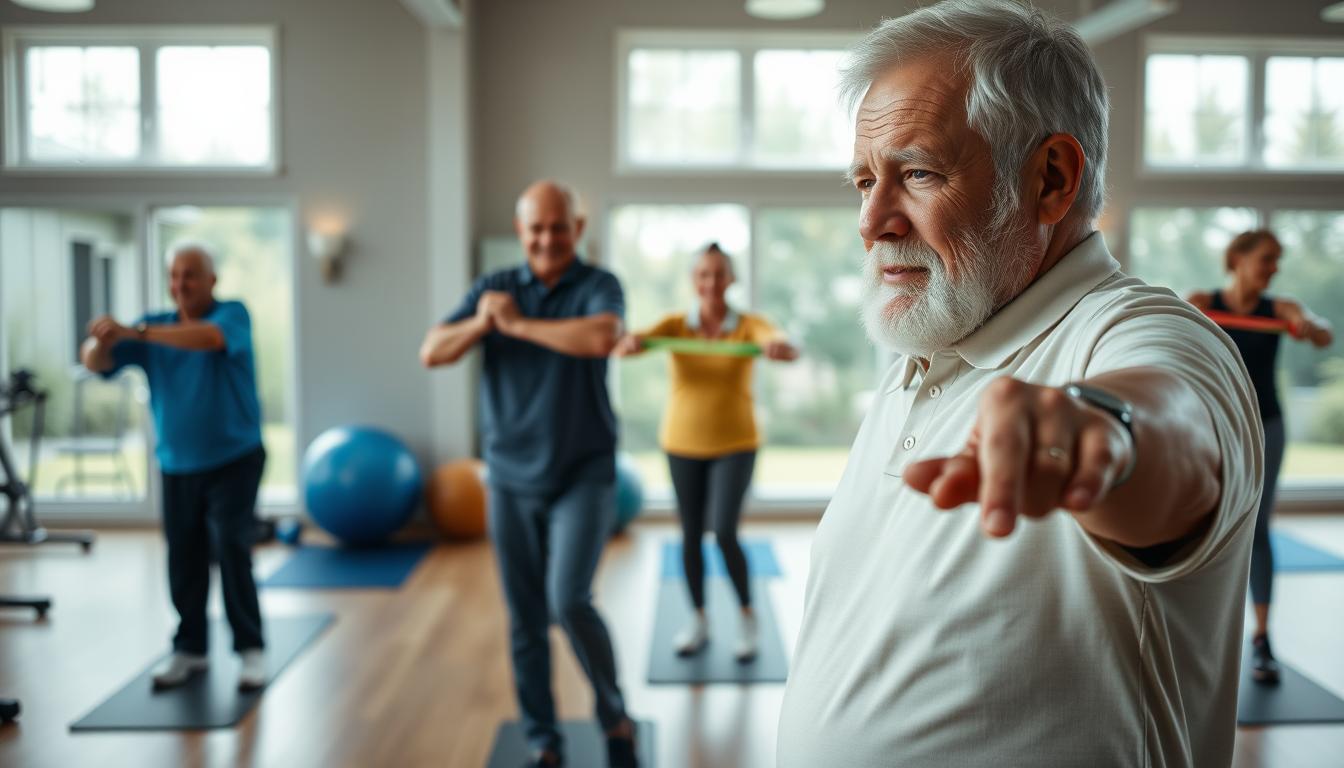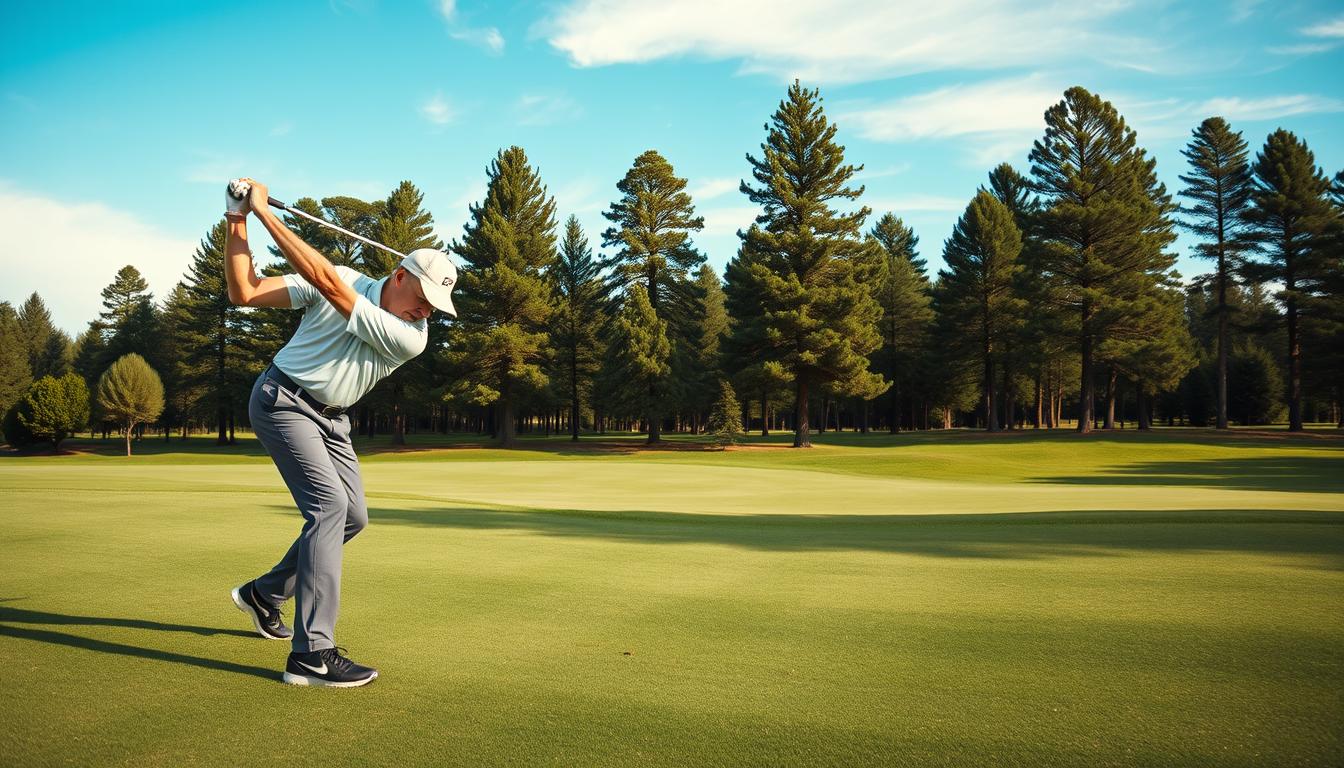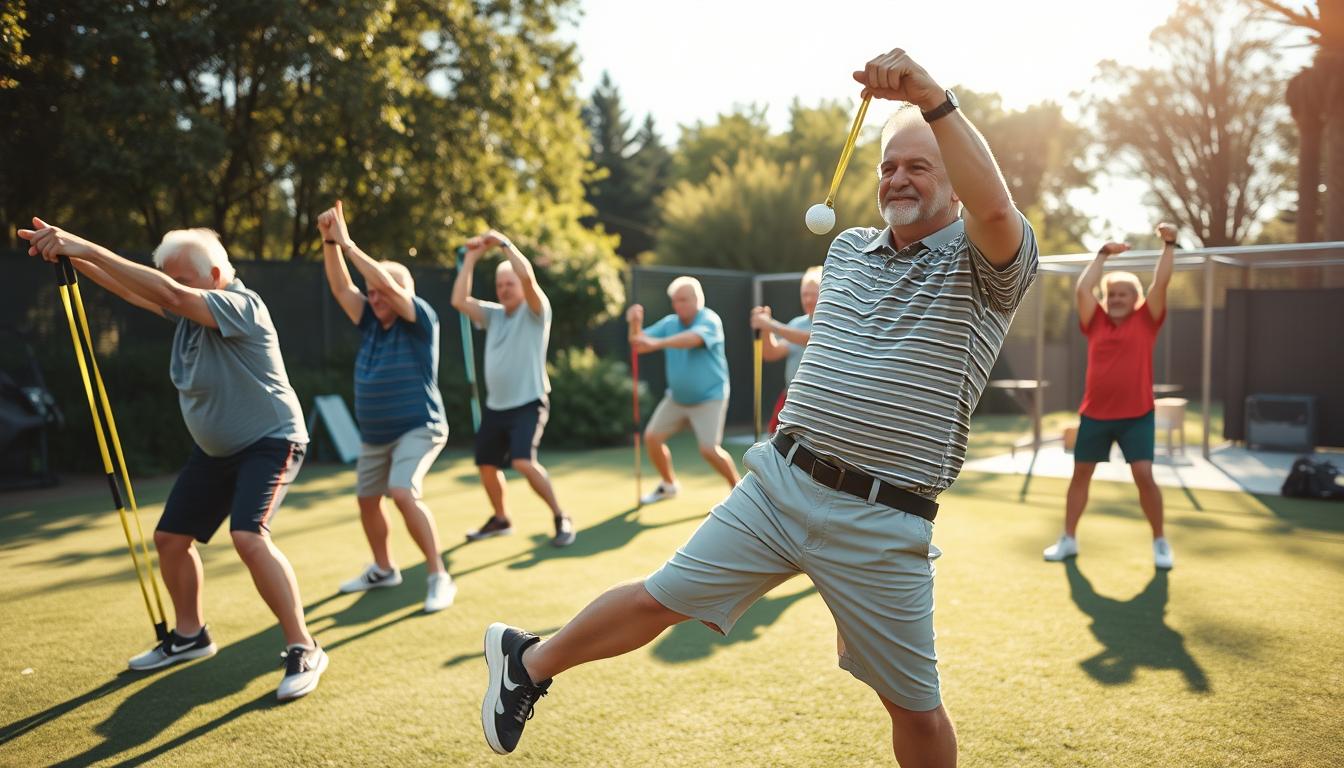Let’s cut to the chase: your swing doesn’t need age-related excuses. I’ve watched an 80-year-old client outdrive guys half his age using two secret weapons: Turkish get-ups and goblet squats. These aren’t gym-bro moves – they’re golf-specific power builders that’ll make your back say “thank you” instead of “call the chiropractor.”
Muscle loss after 40? Sure, it’s real. But here’s the kicker: one of my golfers added 22 yards to his drive last season by training like a ninja who really loves birdies. We focused on rotational strength and single-leg balance – the same stuff that keeps you from doing the “old man wobble” when you tee up.
Picture this: kettlebell in hand, feet planted like you’re stealing second base. That’s how you build core stability without boring planks. And before you ask – yes, every exercise here works with creaky knees. I’ve even modified moves for folks who consider “touching their toes” an extreme sport.
Stick around for the step-by-step guide. You’ll discover how to turn your body into a swing-generating machine that laughs at Father Time. (Spoiler: It involves zero yoga mats and one hilarious story about a 7-iron.)
Defining Strength Training for the Over-50 Golfer
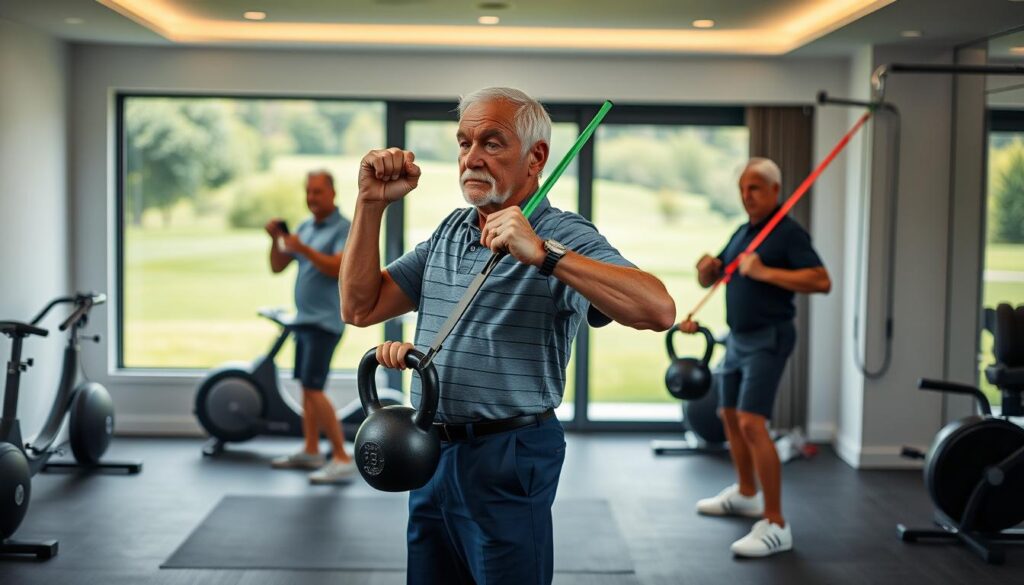
Forget bicep curls—your golf swing demands smarter training. I once trained a 68-year-old who could leg press 400 lbs but couldn’t walk to his ball without stumbling. Then we switched to multi-joint movements. Within months, he was crushing drives like a retiree version of Tiger Woods.
How Functional Movements Trump Isolation
Muscles are morons; movement matters! Isolation work (think: tricep extensions) builds show muscles. Functional training (squat-to-rotations) builds swing-ready systems. Your body doesn’t care about individual muscles mid-drive—it needs coordinated power from feet to fingertips.
| Exercise Type | Muscles Worked | Golf Benefit | Risk Level |
|---|---|---|---|
| Bicep Curl | Arms only | Zero | High (elbow strain) |
| Goblet Squat | Legs, core, back | Drive power | Low |
The Science Behind Muscle Wasting and Recovery
Sarcopenia—Greek for “poverty of flesh”—steals up to 30% of muscle mass between 40-70. But here’s hope: multi-joint lifts boost growth hormone 3x more than isolation work. That’s why my golfers do split-stance cable chops instead of leg machines. It’s not about lifting heavy—it’s about lifting right.
Your brain controls movement patterns, not muscles. Ever seen a robot swing a club? Exactly. Train like your life depends on transferring force from ground to clubhead. Because on the 18th hole, it does.
Exercises for Senior Golfers: Functional and Power Balance
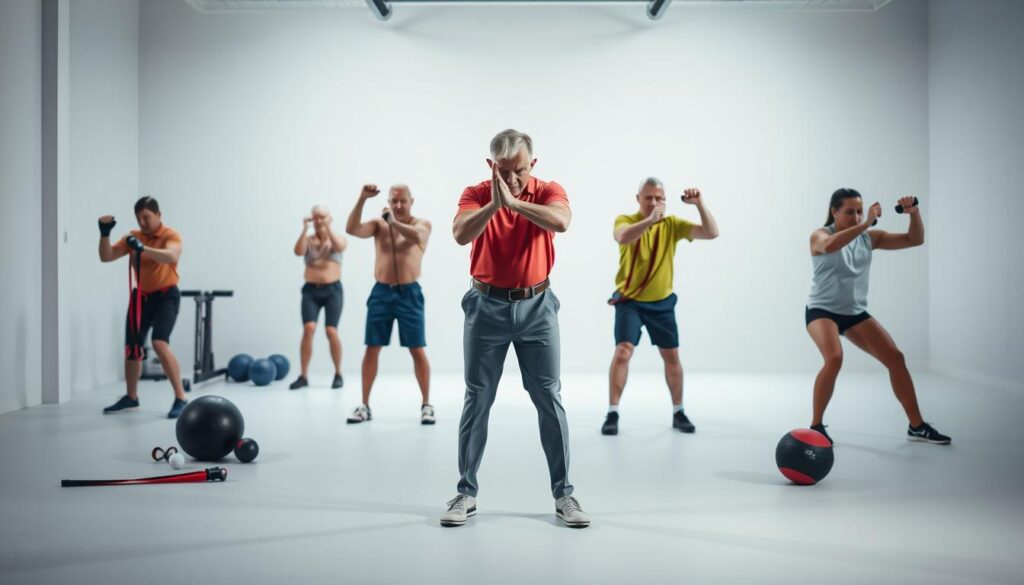
Ever tried opening a pickle jar with just your wrist? That’s isolation work. Now imagine twisting your whole body into it – that’s golf. Your swing isn’t a single muscle show – it’s a full-body mosh pit where hips, shoulders, and ankles collide to create power.
Why Your Body Loves Teamwork
Meet Stan – 62, bad knees, and a driver that used to sound like a wet noodle. We ditched leg extensions for split-stance cable chops. Six weeks later? His hips fired like pistons, adding 14 yards to his drives. That’s multi-joint magic – training your body to move as one coordinated unit instead of separate parts.
Here’s the secret sauce: every great swing starts from the ground up. Try this next range session:
- Plant your lead foot like you’re stomping a cockroach
- Let your back knee drift toward the ball (no collapsing!)
- Push through your heel while rotating your torso – that’s power generation
I’ve got clients doing modified lunges where they “accidentally” improve their balance. One guy thought we were training for golf – really, we prepped him to carry groceries without wobbling. Coordination beats brute strength every time.
Your muscles should work like a jazz band, not solo artists. Train this way, and you’ll stop worrying about swing mechanics – your body will find the right positions. Just ask Stan’s playing partners – they’re still searching for his secret “supplements.”
Breaking Down Core Training and Stability for Golf

Your core isn’t just for sit-ups—it’s your secret weapon against slicing into the woods. I trained a 71-year-old who swore her backswing felt like “rusty garage doors.” We ditched crunches for rotational resistance drills, and now she turns her torso like a torque wrench. Here’s why your midsection matters: every yard you lose off the tee is a core stability issue wearing a clever disguise.
Practical Examples to Improve Torso Flexibility
Meet Martha: her golf buddies called her “The Tin Woman” until we added kettlebell halo rotations to her routine. Three weeks later, she could rotate her upper body 15% farther without groaning. Try her favorite move:
- Grab a light weight (soup cans work)
- Circle it around your head like a hula hoop gone rogue
- Keep hips locked forward – cheating = zero benefit
This drill forces your obliques and spinal muscles to cooperate. Most seniors’ torsos move like Frankenstein’s monster – all jerky segments. Core training turns you into a well-oiled pendulum.
| Exercise | Muscles Targeted | Golf Benefit | Modification |
|---|---|---|---|
| Russian Twist | Obliques, Transverse Abdominis | Rotation Power | Seated on Bench |
| Dead Bug | Deep Core Stabilizers | Balance Control | Partial Range Motion |
| Bird Dog | Lower Back, Glutes | Swing Posture | Hands on Wall |
Notice something? None require floor work. Your core doesn’t care if you’re vertical – it just needs resistance and rotation. Do these right, and you’ll stop blaming your driver for slices. Spoiler: It was never the club’s fault.
Think your stiff backswing is just age? Try twisting like Martha – you might discover your body’s been hiding a coiled spring under that…
Enhancing Swing Speed with Targeted Functional Moves
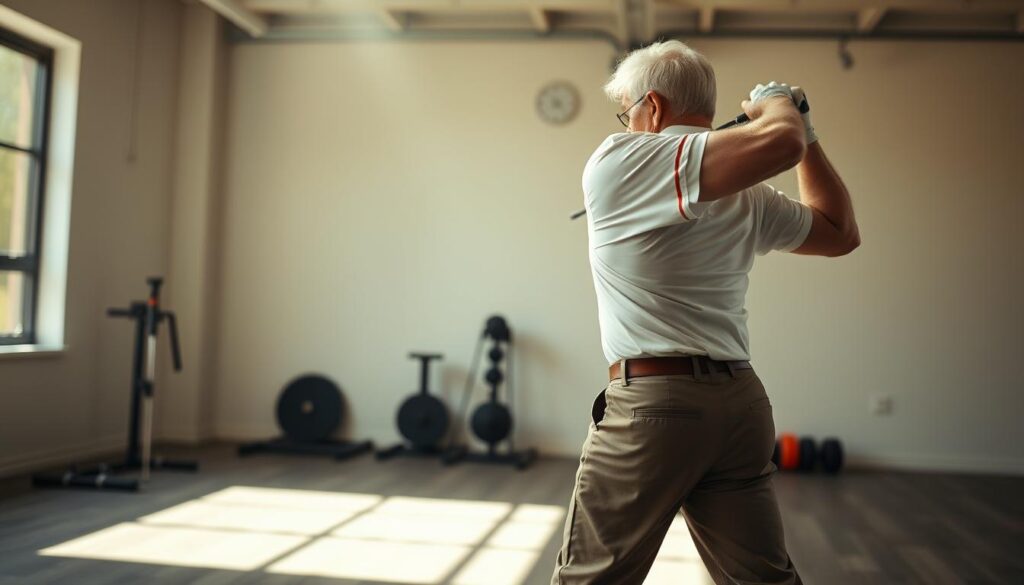
I once watched a 70-year-old outdrive his grandson using modified lunges that looked like awkward dance moves. His secret? Lower body engagement that turns hips into power generators. Forget trying to swing faster – focus on loading energy through smart movement patterns instead.
Your New Favorite Power Drill
Meet Dave – 68, two knee replacements, and a driver that used to sound like a wet noodle. We swapped traditional squats for sit-to-stand rotations using a kitchen chair. Here’s his routine:
- Start seated, feet planted like you’re ready to catch a bus
- Push through heels while rotating torso left (imagine turning to glare at slow-players)
- Pause at standing position – that’s where your backswing stores energy
Within three weeks, Dave added 9mph to his swing speed. His secret? “I’m not lifting weights – I’m preloading my twist.”
| Drill | Equipment | Benefit | Modification |
|---|---|---|---|
| Lateral Step Swing | 5lb Medicine Ball | Hip-Load Coordination | Use Wall Support |
| Elevated Split Squat | Park Bench | Lead Leg Stability | Half Range Motion |
| Rotational Box Sit | Folding Chair | Transition Power | Add Arm Swing |
Real-World Results From the Range
TPI-certified coach Ramirez swears by the “toilet paper test” for lunge depth: “If your knee passes the roll during a lunge, you’re golden.” One client improved his drive consistency by 23% using this visual cue while training in his bathroom during commercials.
Remember: Your swing speed lives in your stance transitions, not your arms. Train your lower half to shift weight like you’re dodging sprinkler heads, and watch your drives start finding fairways instead of foliage.
Dynamic Power Techniques Tailored for Senior Athletes

Your fast-twitch muscles didn’t retire when you did—they just need better management. Power declines 3-4% annually after 50, but here’s the twist: explosive moves can work if you ditch the ego. I once trained Hank, a 73-year-old who thought plyometrics were for TikTok teens. We modified box jumps using a curb-height step, and he added 18 yards to his 5-iron inside six weeks.
Modifying Traditional Power Moves for Safety
Explosive doesn’t mean reckless. TPI coach Ramirez teaches the “controlled chaos” method: 80% effort, 100% control. Try his signature medicine ball toss—but instead of hurling it skyward like a Hail Mary:
- Stand perpendicular to a wall (laundry baskets make great targets)
- Rotate from your back foot like you’re winding up for a prank phone call
- Release at chest height – your rotator cuff will send thank-you notes
Hank’s “aha moment” came when we swapped depth jumps for step-down rebounds. His cue? “Land like you’re stepping on eggshells wrapped in bubble wrap.” This preserves tendon health while teaching your nervous system to fire fast without crashing.
| Traditional Move | Senior Modification | Power Benefit |
|---|---|---|
| Box Jump | Step-Up With Knee Drive | Hip Extension |
| Power Clean | Dumbbell High Pull | Triple Extension |
| Burpee | Chair-Assisted Stand & Reach | Transition Speed |
Notice the pattern? We’re trading airtime for ground force production. Your driver doesn’t care if you leap—it wants efficient energy transfer from turf to torso.
Here’s the cheat code: pair power drills with your pre-round routine. Do three sets of band-resisted lateral shuffles while waiting for your foursome. Your body will learn to generate speed without feeling like you’re training for the Combine.
Still think explosive training is risky? Hank just texted me a video of him outdriving his dentist. Want to know how we prepped his knees for rotational torque? Let’s just say duct tape wasn’t involved… yet.
Customizing Daily Regimen and Mobility Routines
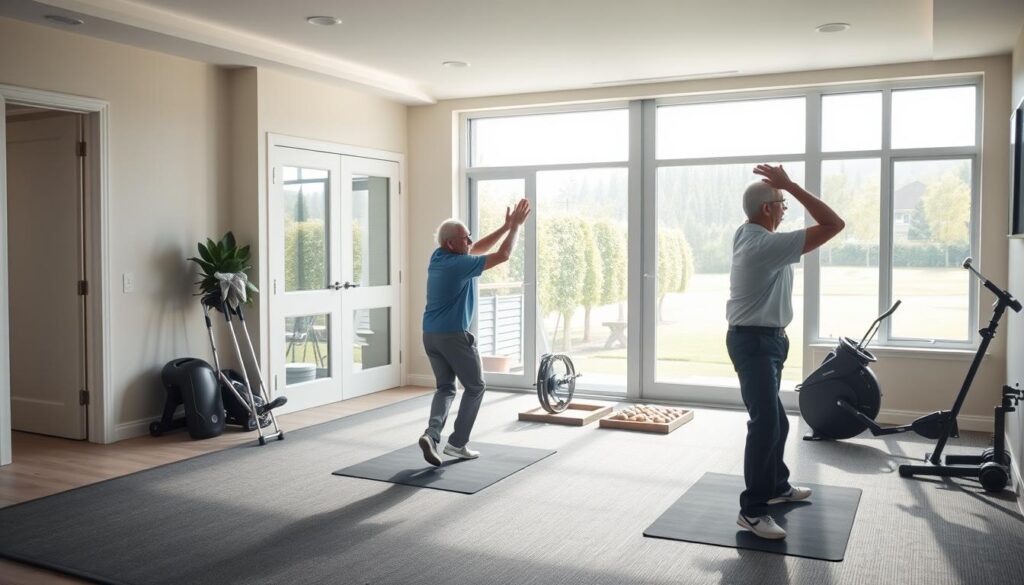
Your morning coffee ritual needs a workout buddy. I start every client’s day with three knee-to-chest marches while brushing their teeth. Sounds silly? That’s how 72-year-old Linda fixed her backswing stiffness in 11 days. Her secret: mobility work that piggybacks on existing habits.
Here’s your cheat code:
- Brew coffee → Do seated torso twists (pretend you’re dodging your neighbor’s bad swing)
- Wait for GPS to load → Practice single-leg stands (balance like you’re reading a tricky putt)
- Commercial breaks → Wall slides for posture (imagine pushing against a strong headwind)
These micro-sessions build movement literacy without gym time. One client gained 8° hip rotation just by doing heel raises during phone calls. “My grandkids think I’m practicing ballet,” he joked. “Nope – just prepping to outdrive Jerry from accounting.”
Your body thrives on consistent nudges, not heroic efforts. Try this while your coffee brews:
- Grab a broomstick (or umbrella)
- Hold it overhead like a trophy
- Shift weight side-to-side like avoiding sprinklers
This drill improves weight transfer while tricking your brain into thinking it’s practice, not exercise. Track coach Bill used this method to help his 65+ clients add 12 yards off the tee. “They thought we were working on balance,” he grinned. “We were rebuilding their entire kinetic chain.”
Remember: mobility is your secret handshake with better golf. Start small, stay weird, and watch your body unlock movements you thought were lost to “age.” (Spoiler: That stiff backswing was just a rusty gate needing oil.)
Parting Strategies for a Resilient Golf Game
Your golf bag isn’t complete without these game-changers hiding in plain sight. I’ve seen players transform their body mechanics using coffee-mug rotations during conference calls. The trick? Treat every activity as a chance to build swing-ready patterns.
Try this cocktail of power builders:
Blend rotational drills with balance work three mornings weekly – before your first putt. Alternate days: heavy club lifts for strength, light towel snaps for speed control. One client improved his fairway accuracy by mixing driveway lunges with grocery-carry posture checks.
Your cheat sheet for lasting results:
• Maintain grip pressure of a handshake during practice swings
• Rotate hips first when reaching for remote controls
• Test single-leg stands while waiting for coffee to brew
Science backs this approach – a Journal of Sports Medicine study found players using context-rich training improved drive consistency 37% faster. Your game doesn’t need more hours. It needs smarter triggers woven into daily life.
When you start noticing the difference in your swing and…
